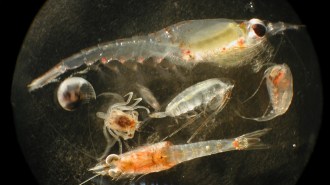Birth control may be having reproductive effects far beyond the bedroom. An analysis by a Swedish scientist suggests that discarded vaginal contraceptive rings could interfere with fishes’ reproduction by releasing estrogen into streams.
Last fall, Joakim Larsson of Göteborg University in Sweden found that a used contraceptive patch can, if flushed down the toilet, shed estrogen into rivers that accept effluent from sewage-treatment facilities (SN: 10/19/02, p. 245: Contraceptive-Patch Worry: Disposal concern focuses on wildlife).
The similarly disposable contraceptive NuvaRing–a vaginally inserted, 3-week, controlled-release estrogen dispenser–contains 2.4 milligrams of estrogen at disposal. That’s 33 percent more than a month’s worth of discarded patches and up to six times as much hormone as in a month’s supply of contraceptive pills, Larsson notes. He’s calculated that just one ring contains enough estrogen to taint 24 million liters of water at concentrations that are biologically active in fish.
Although the ring’s packaging instructs users not to flush the device, “some women may do that anyway,” Larsson says. Moreover, the product’s U.S. manufacturer, Organon of West Orange, N.J., acknowledges that when a woman removes a tampon, has a bowel movement, or strains with constipation, a “NuvaRing can be accidentally expelled” into the toilet.
Sweden’s Medical Products Agency (MPA) asked Larsson to review potential environmental risks of synthetic estrogens in birth control pills, contraceptive rings, and patches. His report in a January newsletter by MPA will go to all Swedish physicians. Unless communities incinerate their trash, Larsson and MPA advocate that users return their used contraceptive products to local pharmacies for disposal.
****************
If you have a comment on this article that you would like considered for publication in Science News, please send it to editors@sciencenews.org.







